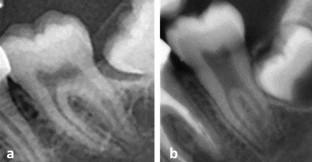Oral Radiology ( IF 1.6 ) Pub Date : 2022-05-25 , DOI: 10.1007/s11282-022-00622-1
Sacide Duman 1 , Emir Faruk Yılmaz 2 , Gözde Eşer 3 , Özer Çelik 4, 5 , Ibrahim Sevki Bayrakdar 5, 6 , Elif Bilgir 6 , Andre Luiz Ferreira Costa 7 , Rohan Jagtap 8 , Kaan Orhan 9, 10

|
Objectives
Artificial intelligence (AI) techniques like convolutional neural network (CNN) are a promising breakthrough that can help clinicians analyze medical imaging, diagnose taurodontism, and make therapeutic decisions. The purpose of the study is to develop and evaluate the function of CNN-based AI model to diagnose teeth with taurodontism in panoramic radiography.
Methods
434 anonymized, mixed-sized panoramic radiography images over the age of 13 years were used to develop automatic taurodont tooth segmentation models using a Pytorch implemented U-Net model. Datasets were split into train, validation, and test groups of both normal and masked images. The data augmentation method was applied to images of trainings and validation groups with vertical flip images, horizontal flip images, and both flip images. The Confusion Matrix was used to determine the model performance.
Results
Among the 43 test group images with 126 labels, there were 109 true positives, 29 false positives, and 17 false negatives. The sensitivity, precision, and F1-score values of taurodont tooth segmentation were 0.8650, 0.7898, and 0.8257, respectively.
Conclusions
CNN’s ability to identify taurodontism produced almost identical results to the labeled training data, and the CNN system achieved close to the expert level results in its ability to detect the taurodontism of teeth.
中文翻译:

使用基于深度学习的卷积神经网络算法检测全景 X 光片上牛齿类牙齿的存在
目标
卷积神经网络 (CNN) 等人工智能 (AI) 技术是一项很有前途的突破,可以帮助临床医生分析医学影像、诊断牛牙症并做出治疗决策。本研究的目的是开发和评估基于 CNN 的 AI 模型在全景放射照相中诊断牛牙畸形牙齿的功能。
方法
使用 Pytorch 实现的 U-Net 模型,使用 434 幅 13 岁以上的匿名、混合大小的全景放射照相图像来开发自动牛齿龙牙齿分割模型。数据集被分为正常和蒙版图像的训练组、验证组和测试组。将数据增强方法应用于具有垂直翻转图像、水平翻转图像和双翻转图像的训练组和验证组的图像。混淆矩阵用于确定模型性能。
结果
在 43 张 126 个标签的测试组图像中,真阳性 109 张,假阳性 29 张,假阴性 17 张。牛齿龙牙齿分割的灵敏度、精度和F 1 分数值分别为 0.8650、0.7898 和 0.8257。
结论
CNN 识别牛牙症的能力产生了与标记训练数据几乎相同的结果,CNN 系统在检测牙齿的牛牙症方面取得了接近专家水平的结果。

































 京公网安备 11010802027423号
京公网安备 11010802027423号